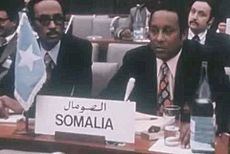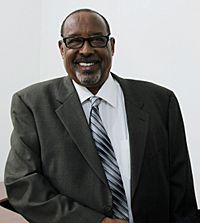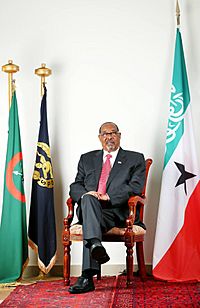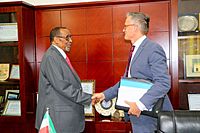Ahmed Mohamed Mohamoud facts for kids
Quick facts for kids
Ahmed Mohamed Mohamoud a.k.a. Silanyo
|
|
|---|---|
|
احمد محمد محمود
|
|
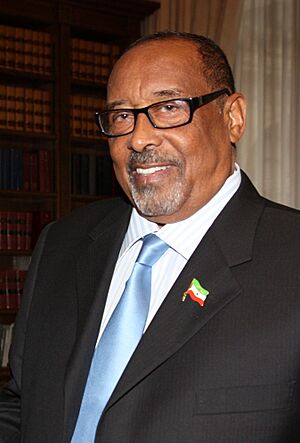
Mohamoud in 2011
|
|
| 4th President of Somaliland | |
| In office 27 July 2010 – 13 December 2017 |
|
| Vice President | Abdirahman Saylici |
| Preceded by | Dahir Riyale Kahin |
| Succeeded by | Muse Bihi Abdi |
| Chairman of Peace, Unity, and Development Party | |
| In office 2002–2010 |
|
| Preceded by | Position established |
| Succeeded by | Muse Bihi Abdi |
| 9th Minister of Finance | |
| In office 1997–1999 |
|
| President | Muhammad Haji Ibrahim Egal |
| Preceded by | Yusuf Ainab Muse |
| Succeeded by | Mohamed Said Mohamed |
| Somaliland House of Representatives | |
| In office 1993–1996 |
|
| Chairman of the Somali National Movement | |
| In office 9 August 1984 – April 1990 |
|
| Preceded by | Colonel Abdiqadir Kosar Abdi |
| Succeeded by | Abdirahman Ahmed Ali Tuur |
| Minister of Commerce of Somalia | |
| In office 1980–1982 |
|
| President | Mohamed Siad Barre |
| In office 1973–1978 |
|
| President | Mohamed Siad Barre |
| Minister of Planning and International Cooperation of Somalia | |
| In office 1965–1973 |
|
| President | Mohamed Siad Barre |
| Personal details | |
| Born | 1938 Burao, British Somaliland (now Somaliland) |
| Died | (aged 86) Hargeisa, Somaliland |
| Citizenship | Somaliland |
| Political party | Peace, Unity, and Development |
| Spouse | Amina-Weris Sh. Mohamed |
| Alma mater | SOS Sheikh Secondary School University of Manchester |
| Signature | |
Ahmed Mohamed Mohamoud "Silanyo" (born 1938 – died 15 November 2024) was an important politician from Somaliland. He served as the 4th President of Somaliland from 2010 to 2017. Before becoming president, he held many government jobs. He was also the leader of the Somali National Movement (SNM) during the 1980s.
In 2010, he ran for president as an opposition candidate and won the election.
Contents
- About Ahmed Mohamed Mohamoud Silanyo
- Ahmed Mohamoud's Political Path
- Early Government Roles
- Leading the Somali National Movement (SNM)
- Building Support for the SNM
- SNM Chairman During Key Years (1984–1990)
- Helping Somaliland Become Independent Again (1990–1996)
- Minister of Finance (1997–1999)
- Minister of Planning and Coordination (1999–2000)
- Mediator and Other Roles (2000–2002)
- Founding the Kulmiye Party (2002–2010)
- Fourth President of Somaliland (2010–2017)
- Achievements as President of Somaliland
- His Passing
- See also
About Ahmed Mohamed Mohamoud Silanyo
His Early Life
Ahmed Mohamed Mohamoud Silanyo was born in 1938 in a town called Burao. This area was then known as British Somaliland, which was a territory controlled by Britain. His nickname "Silanyo" means "lizard" in the Somali language.
Ahmed was the third of six children. His father was a merchant sailor, so his family moved around a lot. Ahmed was the only child in his family to go to school. His uncle, who was a big influence on him, encouraged his education. Ahmed was a Muslim.
His Education Journey
From 1946 to 1957, Mohamoud went to schools in Sheekh and Amud. He finished his high school studies there.
After graduating, he moved to England for more education. Between 1958 and 1960, he studied at London University. He earned an advanced General Certificate of Education (GCE). Then, he went to the University of Manchester. There, he earned a Bachelor's Degree (1960–1963) and a Master's Degree (1963–1965) in Economics.
His Family and Passing
Ahmed Mohamoud met his wife, Amina-Weris Sh. Mohamed, in the late 1960s. She was one of the first Somali women to get a higher education. She trained as a nurse and midwife in England. They got married in Mogadishu in 1968. She was a strong supporter throughout his long political career. They had five children and seven grandchildren.
Mohamoud passed away in Hargeisa, Somaliland, on November 15, 2024. He was 86 years old.
Ahmed Mohamoud's Political Path
Early Government Roles
From 1965 to 1969, Mohamoud worked for the Ministry of Planning in Mogadishu. This was during Somalia's first civilian government. He later became the Minister of Planning (1969–1973) and Minister of Commerce (1973–1978 and 1980–1982). He also led the National Economic Board (1978–1980).
From 1984 to 1990, Mohamoud was the Chairman of the Somali National Movement (SNM). He was the longest-serving leader of this group.
Between 1993 and 1997, Mohamoud was a member of the House of Representatives of Somaliland. He also served as the Somaliland Minister of Finance from 1997 to 1999. In this role, he started a program to improve the country's finances. From 1999 to 2000, he was Somaliland's Minister of Planning. He left this job in 2001.
Leading the Somali National Movement (SNM)
Building Support for the SNM
From 1982 to 1984, Mohamoud was the Chairman of the SNM's branch in the UK. During this time, he set up offices and committees for the SNM across Europe, North America, and the Arab World. His goal was to tell the world about the SNM's fight for freedom. He also wanted to highlight the harsh rule of Somalia's Siyad Barre government. He spoke to human rights groups, the media, and European governments, including the British Parliament.
He also worked to get important people and groups in southern Somalia to join the SNM. The SNM was a group formed mainly by Isaaq members. Their aim was to protect the interests of Somalilanders from the Siyad Barre government. The SNM helped to overthrow the Siyad Barre government in 1991. They were key in bringing back the Republic of Somaliland. Somaliland had united with Somalia in 1960. Today, Somaliland is a self-governing country, but it is seen by most countries as an autonomous region of Somalia.
SNM Chairman During Key Years (1984–1990)
Mohamoud became the SNM's longest-serving Chairman. He led the group during its most challenging and important period. In 1984, the SNM was still quite new. He guided the movement through difficult times.
A major event happened in October 1984. SNM troops launched a big, coordinated attack into the mountainous areas of Somaliland. They also expanded their fronts in the southern and northwest regions.
In 1986, an agreement was made between the Siyad Barre government and Ethiopia's leader, Mengistu Haile Mariam. This agreement aimed to stop supporting rebel groups against their governments. This meant the SNM lost its safe haven in Ethiopia. As a result, in May 1988, the SNM launched a daring attack on the Togdheer and Northwest regions of Somaliland. This attack was a big surprise to both governments. SNM fighters quickly took over the cities of Burao and Hargeisa. Even though the SNM was later pushed out of these cities, this attack severely weakened the Siyad Barre government. It eventually led to a peaceful transfer of power at the 1990 SNM Congress. This peace continues to this day.
Helping Somaliland Become Independent Again (1990–1996)
In May 1991, Mohamoud played a key role at the Congress of Somaliland in Burao. He helped to re-establish Somaliland's independence as a separate state. In 1992, he started a peace meeting that led to a ceasefire agreement. This agreement ended a conflict in the port city of Berbera.
From 1993 to 1996, he was a member of the Somaliland House of Representatives. In 1996, he began a reconciliation effort. This helped to end an internal conflict at Beer, near Burao. A formal agreement to stop fighting and exchange prisoners was made there.
Minister of Finance (1997–1999)
In 1997, Mohamoud became the Minister of Finance for Somaliland. He created and put in place a plan to stop high inflation, which was hurting the economy of Somaliland. He also focused on the military, working to solve problems with supplies for the armed forces. He started a program to improve financial management.
Minister of Planning and Coordination (1999–2000)
Mohamoud then became the Minister of Planning and Coordination for Somaliland. He worked to set up ways for the government to coordinate aid programs with foreign donors. He started a three-year development plan. He also organized a large international conference in Hargeisa to discuss aid for Somaliland. He was the first Somaliland government minister to attend and speak at the Somalia Aid Coordination Body (SACB) in Nairobi, Kenya. He also led a Somaliland delegation that met with representatives from the World Bank and International Monetary Fund (IMF) in Nairobi.
Mediator and Other Roles (2000–2002)
While working with Somaliland's second president, Mohamed Haji Ibrahim Egal, Mohamoud played important roles as a mediator. He helped prevent problems between Djibouti and Somaliland, and between Somaliland and Ethiopia. He also helped resolve issues between SNM veterans and the Egal government, and between the Somaliland House of Representatives and the Egal government.
He spent some time abroad, giving speeches to Somaliland communities in Europe and the United States. He spoke about the country's achievements and developments. When he returned, he worked to solve a national crisis between the Egal government and its political opponents. This crisis almost led to new internal conflict.
Founding the Kulmiye Party (2002–2010)
Mohamoud founded the Kulmiye Party in early 2002. It was the newest political group in the country. The party focused on reaching people in rural areas. Mohamoud chose not to criticize other political parties during his campaign. This helped ensure a peaceful election. He also supported educating the public about the benefits of a multi-party system and democracy.
However, Mohamoud lost the election by only 80 votes to President Dahir Rayaale Kahin. Despite this, Mohamoud supported women's voices in Somaliland. The Kulmiye Party was the only party to appoint a woman as Vice-Chair. In the next elections, Mohamoud received the most votes nationally. Through his leadership, the Kulmiye Party grew to be the largest party in Somaliland.
Even when the ruling party stayed in power after its term ended and seemed unwilling to hold fair elections, Mohamoud continued to seek political change through democratic means. He worked closely with traditional elders and the international community. They were interested in peace and stability in the Horn of Africa. When he ran as the Kulmiye Party candidate for president, he defeated the current President Dahir Rayaale Kahin in the 2010 presidential election.
Fourth President of Somaliland (2010–2017)
Ahmed Mohamoud's term as president ended with the presidential election on November 13, 2017. This election had been delayed from March 28, 2017. The next section highlights some of the important things his administration achieved.
Achievements as President of Somaliland
Stabilizing the Currency
One of the first things his government did was introduce the Somaliland Shilling across the whole country. Before this, the old Somali Shilling was still used in the eastern regions. In 2011, President Silanyo issued an order, approved by Parliament. This made the Somaliland Shilling the only legal money in the country.
Improving Infrastructure
His administration built new offices for many of the country's twenty-four ministries. Since 1991, government ministries were often in old buildings not designed for them. The Silanyo Administration planned and built new offices for many ministries that needed better facilities.
The administration also repaired and rebuilt roads connecting major towns. They also built roads leading to smaller towns in the countryside. The government encouraged and partly funded community-based road construction projects. More importantly, the government started building a 240-mile (384 km) paved road. This road connects Burao City to the town of Erigavo, the capital of the Sanaag Region in the east.
As part of improving infrastructure, the administration made Egal International Airport in Hargeisa and Berbera Airport larger and more secure.
Education and Security Reforms
New laws were passed that made primary education free for everyone.
New rank and salary systems were put in place for the Somaliland Armed Forces, the Somaliland Police, and the Custodial Corps (prison guards).
Water Development Program
Somaliland does not have permanent rivers, and rainfall is often unreliable. Because of this, water is very precious. Water supply systems in the country depend on underground sources. Knowing about the repeated droughts and not enough water in cities and towns, the Silanyo Administration started a water development policy. The main goal of this policy was to drill more boreholes. It also aimed to build dams on dry riverbeds that usually drain water into the sea during the two rainy seasons.
To achieve this, the administration worked on expanding the water supply systems of the six major towns: Hargeisa, Borama, Berbera, Burao, Las Anod, and Erigavo.
Specifically, to help with the constant water shortage in the capital city, Hargeisa, the administration drilled more wells. They also installed larger, rust-resistant pipelines in the Geed Deeble water works. They are also building a dam on the Humboweyne dry river, northeast of Hargeisa.
The administration planned to create a network of wells across the country. They also aimed to dam many of the dry-bed rivers that flow from the Golis Range into the sea.
Partnership for Berbera Port
The administration made an agreement with Dubai Port World (DP World). Under this agreement, DP World will manage Berbera Port for thirty years. They will build a new 400-meter terminal with a container section and a Free Trade Zone. They will also fix up the old port.
In addition, the United Arab Emirates agreed to build a 250 km (156 mile) road. This road will connect Berbera and the border town of Wajaale.
These major agreements will improve the port's capacity and create more jobs. More importantly, they will help trade grow between Somaliland and Ethiopia, which has a population of 102 million people.
His Passing
Ahmed Mohamed Mohamoud 'Ahmed Siilaanyo' passed away on November 15, 2024, in Hargeisa. He was 86 years old and had been ill for a long time.
See also
 In Spanish: Ahmed Mohamed Mahamoud Silanyo para niños
In Spanish: Ahmed Mohamed Mahamoud Silanyo para niños


